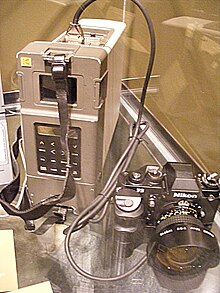
A digital camera, also called a digicam, is a camera that captures photographs in digital memory. Most cameras produced today are digital, largely replacing those that capture images on photographic film. Digital cameras are now widely incorporated into mobile devices like smartphones with the same or more capabilities and features of dedicated cameras. High-end, high-definition dedicated cameras are still commonly used by professionals and those who desire to take higher-quality photographs.
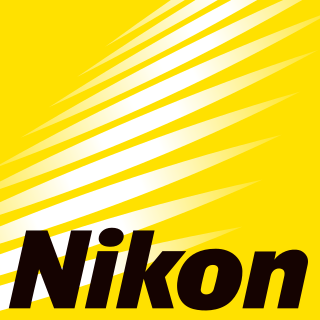
Nikon Corporation is a Japanese optics and photographic equipment manufacturer headquartered in Tokyo, Japan. The companies held by Nikon form the Nikon Group.
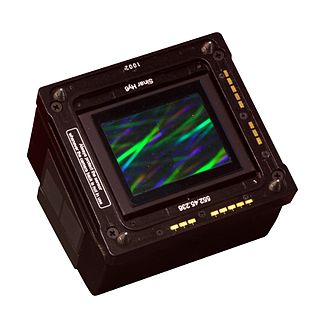
A digital camera back is a device that attaches to the back of a camera in place of the traditional negative film holder and contains an electronic image sensor. This allows cameras that were designed to use film take digital photographs. These camera backs are generally expensive by consumer standards and are primarily built to be attached on medium- and large-format cameras used by professional photographers.

A digital single-lens reflex camera is a digital camera that combines the optics and mechanisms of a single-lens reflex camera with a solid-state image sensor and digitally records the images from the sensor.

A still video camera (SVC) is a type of electronic camera that takes still images and stores them as single frames of video. They peaked in popularity in the late 1980s and can be seen as the predecessor to the digital camera. However, unlike the latter, the image storage in such cameras is based on analog technology, rather than as a digital file.
The Kodak Professional DCS Pro SLR/n is a 13.5 megapixel full-frame 35mm digital SLR produced as a collaboration between Nikon Corporation and Eastman Kodak. It was an improved version of the Kodak Professional DCS Pro 14n series, and was based on a modified Nikon N80 film SLR and thus compatible with almost all Nikon F mount lenses. The camera was announced in early 2004 and became available to purchase mid-year. A monochrome variant named Kodak Professional DCS Pro SLR/n m of the camera existed as well.

The Kodak Professional DCS Pro SLR/c is a 13.5 megapixel digital SLR camera produced by Eastman Kodak. It is full frame—it uses an image sensor that is the full size of a 35 mm frame. It is compatible with Canon EOS lenses. The camera was launched on March 18, 2004, and incorporates the internal systems of the previous Nikon-compatible SLR/n in a Sigma SA9 SLR body.

The Nikon D1 is a digital single-lens reflex camera (DSLR) that was made by Nikon Corporation introduced on June 15, 1999. It features a 2.7-megapixel image sensor, 4.5-frames-per-second continuous shooting, and accepts the full range of Nikon F-mount lenses. The camera body strongly resembles the F5 and has the same general layout of controls, allowing users of Nikon film SLR cameras to quickly become proficient in using the camera. Autofocus speed on the D1 series bodies is extremely fast, even with "screw-driven" AF lenses.

Steven J. Sasson is an American electrical engineer and the inventor of the self-contained (portable) digital camera. He joined Kodak shortly after his graduation from engineering school and retired from Kodak in 2009.
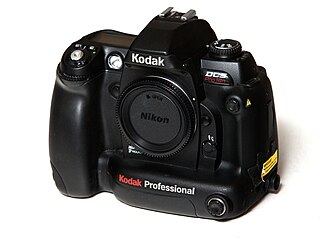
The Kodak Professional DCS Pro 14n is a professional Nikon F80 based F-mount digital SLR produced by Eastman Kodak. It was announced at the photographic trade show photokina in Germany during September 2002; production examples became available in May 2003.

The Kodak DCS 300 series comprises two cameras, the DCS 315 and DCS 330. They are professional-level digital SLR cameras built by Eastman Kodak's Kodak Professional Imaging Solutions division. They were based on the Nikon Pronea 6i APS SLR camera and were aimed at a lower price point than other models in the Kodak DCS range. The 1.5 megapixel DCS 315 was launched in 1998, while the 3 megapixel DCS 330 was launched in 1999. The DCS 315 was the first digital SLR camera to incorporate an image preview LCD and inbuilt JPEG processing.

The history of the camera began even before the introduction of photography. Cameras evolved from the camera obscura through many generations of photographic technology – daguerreotypes, calotypes, dry plates, film – to the modern day with digital cameras and camera phones.
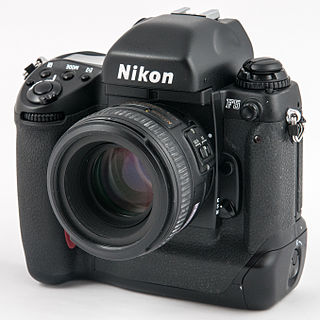
The Nikon F5 is a professional 35 mm film-based single-lens reflex camera body manufactured by Nikon from 1996 through 2004. It was the fifth in Nikon's professional film camera line, which began in 1959 with the Nikon F. It followed the Nikon F4 of 1988, which introduced in-body autofocus to Nikon's professional line. The F5 was in turn succeeded by the Nikon F6, as well as Nikon's parallel range of professional digital SLRs, beginning with the Nikon D1.

Digital photography uses cameras containing arrays of electronic photodetectors interfaced to an analog-to-digital converter (ADC) to produce images focused by a lens, as opposed to an exposure on photographic film. The digitized image is stored as a computer file ready for further digital processing, viewing, electronic publishing, or digital printing. It is a form of digital imaging based on gathering visible light.

The Canon EOS D2000 is a 2-megapixel digital single-lens reflex camera developed by Kodak on a Canon EOS-1N body. It was released in March 1998. It features a CCD sensor and can shoot at 3.5 frames per second. Many enthusiasts regard the D2000 as Canon's first truly usable Digital SLR. It was released in tandem with the Canon EOS D6000, a 6-megapixel model.

The Kodak Digital Camera System is a series of digital single-lens reflex cameras and digital camera backs that were released by Kodak in the 1990s and 2000s, and discontinued in 2005. They are all based on existing 35mm film SLRs from Nikon, Canon and Sigma. The range includes the original Kodak DCS, the first commercially available digital SLR.

The Canon EOS DCS 3 was Kodak's second Canon based Digital SLR camera released in July 1995, four months after Kodak EOS-DCS 5. It uses a modified Canon EOS-1N film camera with a modified Kodak NC2000e digital camera back attached. As a result, it maintained the Canon EF lens mount, and full compatibility with all of Canon's EF lenses made until that time. The camera was followed by the six megapixel Canon EOS DCS 1, which was released later in December 1995.

The Nikon E series, co-developed with Fujifilm, are autofocus 1.3 megapixel professional grade quasi-full frame (35mm) Nikon F-mount digital single lens reflex cameras (DSLR) manufactured by Nikon since 1995.
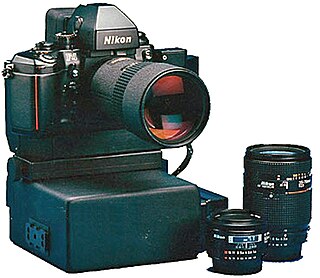
The Nikon NASA F4 Electronic Still Camera is one of the first and rarest fully digital cameras with development started in 1987. While Nikon delivered a modified Nikon F4 body, most of the electronics for the digital camera and housings were designed and manufactured by NASA at the Johnson Space Center and other suppliers. It was first flown in September 1991 on board the Space Shuttle Discovery, mission STS-48. Later the cameras were flown on several other Shuttle missions including STS-44, 45, 42, 49, 53, 56 and 61.

The Apple QuickTake is one of the first consumer digital camera lines. It was launched in 1994 by Apple Computer and was marketed for three years before being discontinued in 1997. Three models of the product were built including the 100 and 150, both built by Chinon; and the 200, built by Fujifilm. The QuickTake cameras had a resolution of 640 x 480 pixels maximum.
